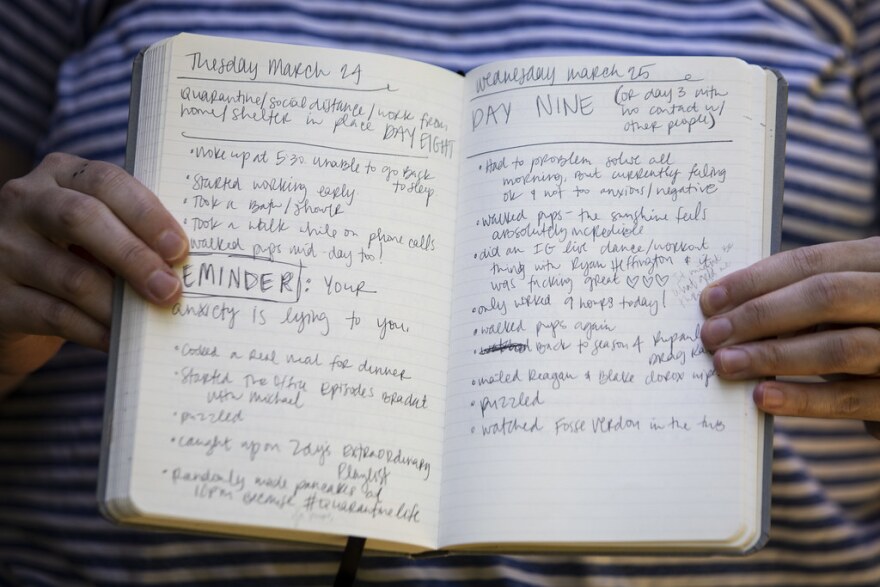Wake up. Eat breakfast. Don’t leave the house. Work from home. Think about what else is to come. Don’t leave the house. Hang out with friends over Zoom. Watch TV. Leave the house – but wear a mask. Worry. Feel grateful. Worry. Get sad. Don’t leave the house. Do it all again, with some slight variation, the next day.
If you keep a journal, it might read like this right now. Typically, journals are private and no one else gets to read them. But we're living through a pandemic, so recordings of our day-to-day lives are more novel and, in a sense, more valuable. That's why institutions across the country – from the National Museum of American History to the Chicago History Museum to the Austin History Center – want to put our diaries on display.
“That kind of small documentation actually really sheds light on what life was like right now,” Madeline Moya, a media archivist with the Austin History Center, said. “It seems insignificant to people, but it really is a historical document.”
Last month, the Austin History Center put out a call: Send us your photos, your videos, your writings about living through the COVID-19 pandemic. Since then, Moya said, it has received poetry, drawings and paintings. The center is interested in business records, she said, especially as some restaurants announce permanent closures amid the pandemic recession.
As of Monday morning, 95 people had sent in documents.
“We wanted to get it now while it was happening,” Moya said. “Before the memories faded and people moved on to trying to recover.”

Samantha White lives with her husband and two dogs and works for a local pharmacy. White says she was an avid journaler before the pandemic and is even more so now; she’s been keeping a separate tally of what she eats, thinks and does each day.
“Tuesday, March 17th. Work from home/Quarantine/Social Distancing Day 1,” is how her first entry begins on the day Austin Mayor Steve Adler ordered all restaurants and bars to close.
“It’ll be interesting to see how long all of this lasts,” she wrote.
As the days went on, she chronicled walking her dogs, baking bread, sitting in her hammock. She wrote about feeling grateful that the constant one-on-one time with her husband had not yet led to any friction, and then later about how all the uncertainty surrounding the pandemic made her sad.
“At the beginning I was writing down all of these thoughts and feelings and wondering what was going to happen. There was so much uncertainty,” White said.
But then each day started feeling the same and White got frustrated.
“You could tell I was annoyed that I was having to write all of this down. OK, here we are, day 25. Nothing's changed. I ate this for lunch," she said.
While White said she finds documenting her days to be less cathartic and possibly making her more anxious, for others it helps.
Samuel Robinson, 12, has been producing short video roundups of the news every day, posting them to YouTube. He reads as much news as he can about COVID-19, and then whittles it down to what he thinks people need to know.
“The thing about myself is when I don't know something, I get very anxious and stressful,” he said. “It helps me.”
He calls it “The Daily Samuel.” On April 19, he informed viewers – many of whom are his parents’ friends – of the total number of cases in the U.S. and worldwide, and that President Donald Trump had said the U.S. will begin manufacturing more coronavirus test kits.
Samuel said he did try to keep a journal, but it wasn’t for him.
“I wrote one entry and it said, ‘I am going insane,'" he said.
Others are documenting the pandemic through art. UT Austin Professor Megan Hildebrandt has been asking for friends to send her short descriptions of their homes during the pandemic; using a bamboo stick and ink, she turns these into drawings for a series called “Households in Quarantine.”
“These just look like scenes of daily life, because they are,” she said. “But it's just a really particular daily life right now.”
Take the drawing titled, “Jenny in Washington on 3/16/20.” Hildebrandt’s friend told her she’d been woken up one morning by her two kids jumping on her. Awake, she quickly realized she had pink eye, likely contracted from one of them.

Hildebrandt set out to recreate her friend’s quarantine household scene. She drew two children, one with enormous legs and no torso, jumping on a woman in bed. You can see something radiating from the woman’s eye, perhaps puss. The drawing, like the rest in her series, is stark, drawn quickly –there's no erasing with bamboo ink – with a sense of apathy that makes you want to laugh, despite everything else.
Hildebrandt describes the drawings as being at the intersection of “fear, humor, banality” – a scene from a pandemic.
She decided to donate her drawings to the Austin History Center’s COVID-19 collection because she wanted to be a part of her community’s history.
That’s what Moya with the Austin History Center was hoping might inspire people to contribute.
“Having this opportunity to contribute to the city's history we thought could be important for people while they're in their homes,” she said.
Got a tip? Email Audrey McGlinchy at audrey@kut.org. Follow her on Twitter @AKMcGlinchy.
If you found the reporting above valuable, please consider making a donation to support it. Your gift pays for everything you find on KUT.org. Thanks for donating today.



